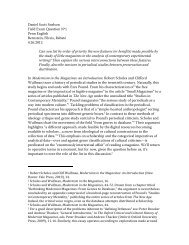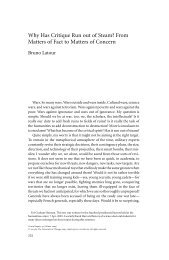The Exploit: A Theory of Networks - asounder
The Exploit: A Theory of Networks - asounder
The Exploit: A Theory of Networks - asounder
You also want an ePaper? Increase the reach of your titles
YUMPU automatically turns print PDFs into web optimized ePapers that Google loves.
Nodes 65<br />
face because enmity is always “faced” or constituted by a confrontation.<br />
We stand alongside our friends; I stand opposite my foe. Friends only<br />
“face” each other ins<strong>of</strong>ar as they stand opposite and “face” their common<br />
foe (their enmity - in - common). Enmity is an interface.<br />
<strong>The</strong> Schmittian friend - foe distinction is not just political in the<br />
military sense but political in the ethical sense, too. <strong>The</strong> basis <strong>of</strong> the<br />
friend - foe distinction is intimately related to the relation between<br />
self and other. But this self - other relation need not be a rapid fire <strong>of</strong><br />
glances, gazes, and recognition (as in the Hegelian - Kojèvean model).<br />
For Levinas, ethics is first constituted by the ambiguous calling <strong>of</strong><br />
the “face” <strong>of</strong> the other, for there is an affective dynamic at work<br />
between self and other that revolves and devolves around the “face”<br />
(a verb more than noun): “<strong>The</strong> proximity <strong>of</strong> the other is the face’s<br />
meaning, and it means from the very start in a way that goes beyond<br />
those plastic forms which forever try to cover the face like a mask <strong>of</strong><br />
their presence to perception.” 33 Perhaps there is something to be<br />
learned by positioning Levinas in relation to Schmitt on this issue. A<br />
self does not set out, avant la lettre, to identify friend or foe according<br />
to preexisting criteria (political, military, ethical). Rather, the strange<br />
event <strong>of</strong> the “face” calls out to the self, in a kind <strong>of</strong> binding, intimate<br />
challenge: “<strong>The</strong> Other becomes my neighbor precisely through the<br />
way the face summons me, calls for me, begs for me, and in so doing<br />
recalls my responsibility, and calls me into question.” 34 What implications<br />
does this have for enmity? Certainly that the self exists for<br />
the other. But it is much more than this. Enmity is not simply some<br />
final, absolute split (friend/ foe, self/ other) but rather a proliferation<br />
<strong>of</strong> faces and facings, whose very spatiality and momentary, illusory<br />
constrictions create the conditions <strong>of</strong> possibility for enmity in both<br />
its political and military forms (facing - allies, facing - enemies). Friends,<br />
foes, selves—there are faces everywhere.<br />
But what <strong>of</strong> an enmity without a face? What <strong>of</strong> a defacement <strong>of</strong> enmity?<br />
This is where a consideration <strong>of</strong> politico - military topologies comes<br />
into focus. Enmity is dramatized or played out in the pragmatic and<br />
material fields <strong>of</strong> strategy and war. <strong>The</strong> emerging “new symmetry”









